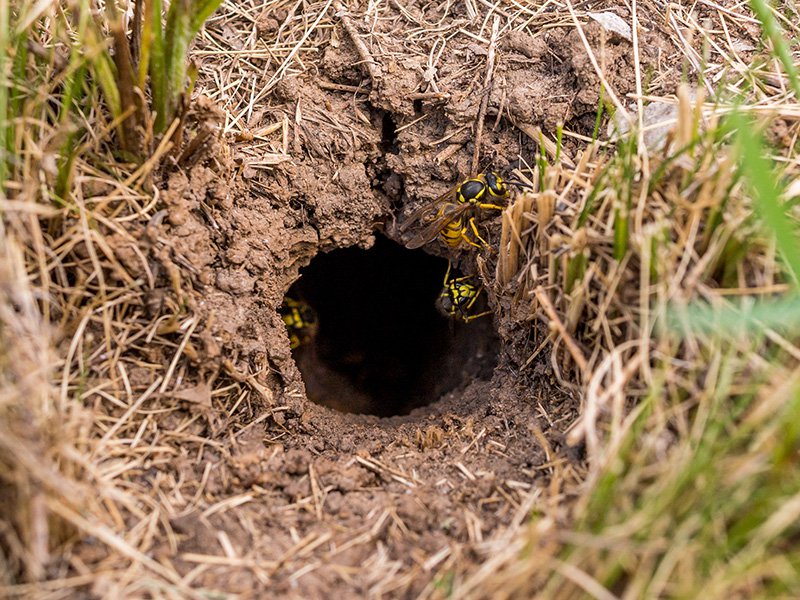Why Wasps Love Your Yard
Wasps build nests in places that give them everything they need: food, water, and shelter. If your yard checks all those boxes, it’s an open invitation.
Stinging insects consume sugary foods like fruit and nectar, but they may also crave protein, such as insects, meat scraps, and pet food left outdoors. Fruit trees, flowering plants, and open garbage bins are like buffets. Leaky faucets, puddles, or damp soil provide the water wasps need to survive.
As for where they build their nests, it depends on the species:
- Paper wasps hang their nests from eaves, tree branches, or porch ceilings.
- Yellow jackets often go underground, hiding nests in burrows, hollow trees, or wall voids.
- Bald-faced hornets build large, enclosed aerial nests, often the size of a football or larger, typically found in trees, shrubs, or high up on buildings.
What Happens If You Mow Too Close
Getting too close to a wasp nestin the ground, especially with a noisy lawn mower, can turn dangerous fast. Wasps are territorial and will defend their nest aggressively. Unlike bees, they can sting multiple times, and their stings hurt.
Yellow jackets can swarm out in seconds if you accidentally mow over a hidden ground nest. It’s not just one sting you must worry about; it’s dozens. This can become a medical emergency in minutes for anyone with a wasp allergy.
Bottom line: disturbing a nest, even unintentionally, can trigger a serious attack.
How to Spot a Nest Before You Mow
Before working in the yard, take a few minutes to scan the area. A quick walk-through can make all the difference.
Here’s how to inspect for a wasp nest:
- Walk the yard early in the morning or late evening when wasp activity is low.
- Watch for wasps flying in and out of a particular spot—that usually means a nearby nest.
- Check high (under eaves, tree limbs, furniture) and low (ground holes, landscaping).
- Listen for buzzing.
- If you find a nest, don’t get close—just back away slowly.
DIY vs. Professional Help
Once you’ve found a nest, the question is: now what?
Blasting a nest with a hose, dousing it with bug spray, or implementing other DIY strategies might seem tempting, but they are usually bad ideas. These methods often just agitate the wasps, which increases your chance of getting stung. And even if it looks like you got rid of them, there’s no guarantee they won’t come back or relocate nearby.
The best course of action is to call in the pros. At Big Time Pest Control, we have the gear and training to remove nests wholly and safely, no stings, guesswork, or recurring nests.
Preventing Future Nesting
To avoid a wasp problem in the future, there are some preventative measures you can take, both now and next season. Big Time Pest Control recommends:
- Keeping garbage bins stored away from your house and with tightly-fitting lids
- Picking up fallen fruit
- Cleaning up thoroughly after outdoor meals
- Fixing dripping spigots or leaky pipes
- Filling in holes or depressions in your lawn
- Cutting back foliage to reduce moisture build-up in landscape beds
- Removing areas of standing water
- Cutting back tree limbs
- Sealing cracks and holes in your siding
- Contacting the professionals at the first signs of a stinging insect problem
Contact Big Time Pest Control for Wasp Control That Works
If you think you’ve spotted a wasp’s nest in your yard, especially if it’s close to where you plan to work outdoors or where your family spends time, contact Big Time Pest Control. We provide fast, reliable service to remove wasp nests so you can enjoy your yard and outdoor living space!


















